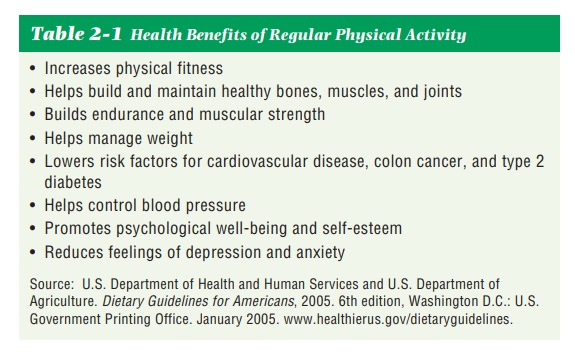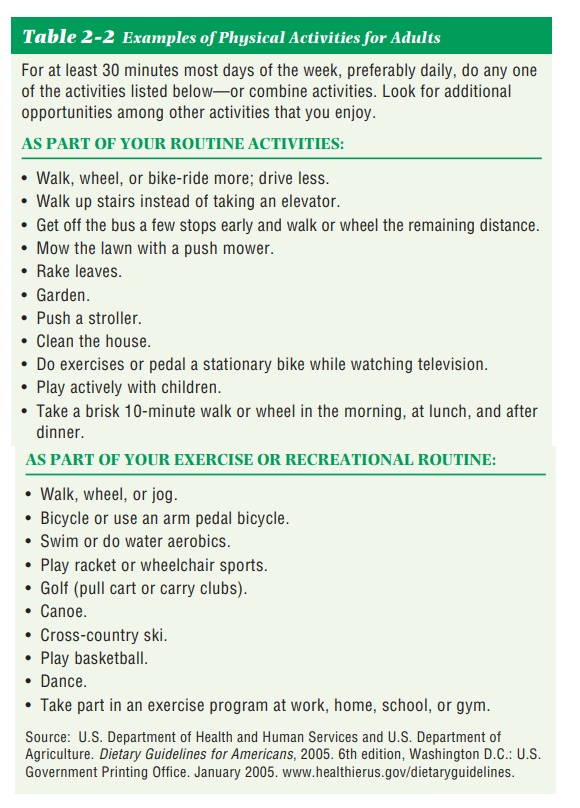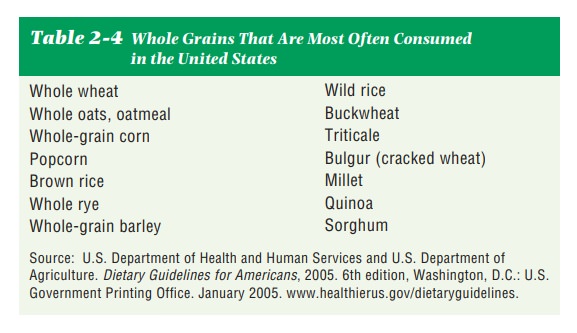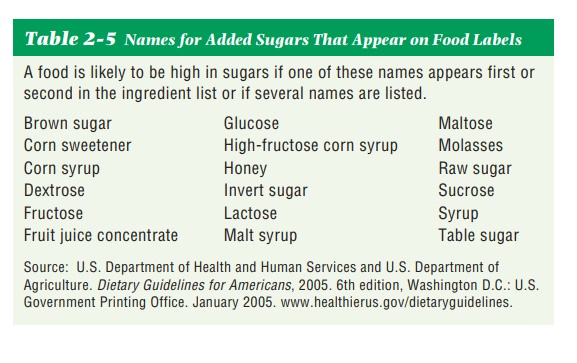Chapter: Nutrition and Diet Therapy: Planning a Healthy Diet
Dietary Guidelines
DIETARY GUIDELINES FOR
AMERICANS
The Dietary Guidelines
provide science-based advice to promote health and to reduce the risk for
chronic diseases through diet and physical activity. The guidelines are
targeted to the general public over 2 years of age in the United States. Below
are the titles of the topics for each section; all of the following key
recommendations are taken from www. health.gov/dietaryguidelines. The Dietary
Guidelines themselves form an integrated set of key recommendations in each of
the topic areas and will be discussed under the respective topics.
· Adequate nutrients
within calorie needs
· Weight management
· Physical activity
· Food groups to
encourage
· Fats
· Carbohydrates
· Sodium and potassium
· Alcoholic beverages
· Food safety
Adequate Nutrients within Calorie Needs
A basic premise of the
Dietary Guidelines is that recommended diets will provide all the nutrients
needed for growth and health and that the nutrients consumed should come
primarily from foods. Foods contain not only the vitamins and min-erals found
in supplements, but also hundreds of naturally occurring substances, including
carotenoids, flavonoids and isoflavones, and protease inhibitors that may
protect against chronic health conditions.
Key Recommendations.
· Consume a variety of
nutrient-dense foods and beverages withinand among the basic food groups while
choosing foods that limit the intake of saturated and trans fats, cholesterol,
added sugars, salt, and alcohol.
· Meet recommended
intakes within energy needs by adopting abalanced eating pattern such as the
USDA Food Guide or the Dietary Approaches to Stop Hypertension (DASH) Eating
Plan (Appendix C-1).
Key Recommendations for Specific Population Groups.
· People over age 50.Consume vitamin B12in
its crystalline form(e.g., fortified foods or supplements).
· Women of childbearing age who may become
pregnant.Eat foodshigh in heme-iron and consume iron-rich plant foods or
iron-fortified foods with an enhancer of iron absorption, such as vitamin
C–rich foods.
· Women of childbearing age who may become
pregnant and those in thefirst trimester of pregnancy. Consume adequate
synthetic folic aciddaily (from fortified foods or supplements) in addition to
food forms of folate from a varied diet.
· Older adults, people with dark skin, and people exposed to insufficientultraviolet band-radiation (i.e., sunlight). Consume extra vitamin Dfrom vitamin D–fortified foods and supplements.
Weight Management
Over the last 20 years
the prevalence of overweight in the general population, and especially among
children and adolescents, has increased substantially; it is estimated that as
many as 16% of children and adolescents are overweight. Overweight and obesity
of both adults and children are of great public health concern because excess
body fat leads to a higher risk of premature death, type 2 diabetes, hypertension,
dyslipidemia, cardiovascular disease, stroke, gall-bladder disease, and other
chronic diseases.
Key Recommendations.
· To maintain body
weight in a healthy range, balance calories fromfoods and beverages with
calories expended.
· To prevent gradual
weight gain over time, make small decreases infood and beverage calories and
increase physical activity.
Key Recommendations for Specific Population Groups.
· Those who need to lose weight.Aim for a slow, steady
weight loss bydecreasing calorie intake while maintaining an adequate nutrient
intake and increasing physical activity.
· Overweight children.Reduce the rate of
body weight gain whileallowing growth and development. Consult a health care
provider before placing a child on a weight reduction diet.
· Pregnant women.Ensure appropriate
weight gain as specified by ahealth care provider.
· Breastfeeding women.Moderate weight
reduction is safe and does notcompromise weight gain of the nursing infant.
· Overweight adults and overweight children with
chronic diseaseand/or on medication. Consult a health care
provider about weightloss strategies before starting a weight reduction program
to ensure appropriate management of other health conditions.
Physical Activity
Americans are relatively inactive. Regular physical activity and physical fitness make important contributions to one’s health, sense of well-being, and maintenance of a healthy body weight. Physical activity is defined as any bodily movement produced by skeletal muscles resulting in energy expenditure. Regular physical activity has been shown to reduce the risk of certain chronic diseases, including high blood pressure, stroke, coronary artery disease, type 2 diabetes, colon cancer, and osteoporosis. Therefore, it is recommended that adults engage in at least 30 minutes of moderate-intensity physical activity on most days of the week. Regular physical activity is also a key factor in achieving and maintaining a healthy body weight for adults and children (Tables 2-1, 2-2, and 2-3). It is recommended that males over age 40 and females over age 50 check with their health care provider before beginning aerobic activities.



Key Recommendations.
·
Engage in regular physical activity and reduce
sedentary activities topromote health, psychological well-being, and healthy
body weight.
·
To reduce the risk of chronic disease in
adulthood, engage in at least 30 minutes of moderate-intensity physical
activity, above usual activity, at work or home on most days of the week. For
most people, greater health benefits can be obtained by engaging in physical
activity of more vigorous intensity or longer duration.
·
To help manage body weight and prevent
gradual, unhealthybody weight gain in adulthood, engage in approximately 60
minutes of moderate- to vigorous-intensity activity on most days of the week
while not exceeding caloric intake requirements.
·
To sustain weight loss in adulthood,
participate in at least 60 to90 minutes of daily moderate-intensity physical
activity while not exceeding caloric intake requirements. Some people may need
to consult with a health care provider before participating in this level of
activity.
·
Achieve physical fitness by including
cardiovascular conditioning,stretching exercises for flexibility, and
resistance exercises or calisthenics for muscle strength and endurance.
Key Recommendations for Specific Population Groups.
·
Children and
adolescents.Engage in at least 60 minutes of physicalactivity on most,
preferably all, days of the week.
·
Pregnant women.In the absence of
medical or obstetriccomplications, incorporate 30 minutes or more of
moderate-intensity physical activity on most, if not all, days of the week.
Avoid activities with a high risk of falling or abdominal trauma.
·
Breastfeeding women.Be aware that neither
acute nor regular exerciseadversely affects the mother’s ability to
successfully breastfeed.
·
Older adults.Participate in regular
physical activity to reducefunctional declines associated with aging and to
achieve the other benefits of physical activity identified for all adults.
Food Groups to Encourage
Increased intakes of fruits, vegetables, whole grains, and fat-free or low-fat milk products will have important health benefits. Those who eat more generous amounts of fruits and vegetables as part of a healthful diet may reduce the risk of chronic diseases, including stroke and other cardiovascular diseases, type 2 diabetes, and cancers in certain sites (oral cavity and pharynx, larynx, lung, esophagus, stomach, and colon-rectum). In addition to fruits and vegetables, whole grains are an important source of fiber and other nutrients. Consuming at least three or more ounce-equivalents of whole grains per day can reduce the risk of several chronic diseases and may help with weight maintenance.
Table 2-4 can help one
recognize the names of whole grains.

Key Recommendations.
· Consume a sufficient
amount of fruits and vegetables while stayingwithin energy needs. For a
2,000-calorie intake, 2 cups of fruit and
· 21⁄2 cups
of vegetables per day are recommended, with higher or lower amounts depending
on the calorie level.
· Choose a variety of
fruits and vegetables each day. In particular,select from all five vegetable
subgroups (dark green vegetables, orange vegetables, legumes, starchy vegetables,
and other vegetables) several times a week.
· Consume three or more
ounce-equivalents of whole-grain productsper day, with the rest of the
recommended grains coming from enriched or whole-grain products. In general, at
least half the grains should come from whole grains.
· Consume 3 cups per day
of fat-free or low-fat milk or equivalent milkproducts.
Key Recommendations for Specific Population Groups.
·
Children and
adolescents.Consume whole-grain products often; at leasthalf the grains
should be whole grains. Children 2 to 8 years should consume 2 cups per day of
fat-free or low-fat milk or equivalent milk products. Children 9 years of age
and older should consume 3 cups per day of fat-free or low-fat milk or
equivalent milk products.
Fats
Fats and oils are part
of a healthful diet, but the type of fat makes a difference to heart health,
and the total amount of fat consumed is also important. High in-take of
saturated fats, trans fats, and cholesterol increases the risk of coronary
heart disease due to high blood lipid levels. Fats supply energy and
essentialfatty acids and serve as a carrier for the absorption of the
fat-soluble vitamins A, D, E, and K and carotenoids.
Key Recommendations.
· Consume less than 10% of calories from
saturated fatty acids andless than 300 mg/day of cholesterol and keep
trans-fatty acid consumption as low as possible.
·
Keep total fat intake between 20 and 35% of
calories, with mostfats coming from sources of polyunsaturated and
monounsaturated fatty acids, such as fish, nuts, and vegetable oils.
·
When selecting and preparing meat, poultry,
dry beans, and milk or milk products, make choices that are lean, low fat, or
fat-free.
·
Limit intake of fats and oils high in
saturated and trans-fatty acids,and choose products low in such fats and oils.
Key Recommendations for Specific Population Groups.
·
Children and
adolescents.Keep total fat intake between 30 and 35% ofcalories for children
2 to 3 years of age and between 25 and 35% of calories for children and
adolescents 4 to 18 years of age, with most fats coming from sources of
polyunsaturated and monounsaturated fatty acids, such as fish, nuts, and
vegetable oils.
Carbohydrates
Carbohydrates are part
of a healthful diet. Foods in the basic food groups that provide
carbohydrates—fruits, vegetables, grains, and milk—are important sources of
many nutrients. Dietary fiber is composed of nondigestible carbohy-drates.
Sugars and starches supply energy to the body in the form of glucose. Sugars
can be naturally present in foods or added to the food. The greater the
consumption of foods containing large amounts of added sugars, the more
dif-ficult it is to consume enough nutrients without gaining weight. See Table
2-5 to help identify the names of added sugar on labels.

Key Recommendations.
• Choose fiber-rich
fruits, vegetables, and whole grains often.
• Choose and prepare
foods and beverages with little added sugarsor caloric sweeteners, such as the
amounts suggested by the USDA MyPyramid and the DASH Eating Plan.
• Reduce the incidence
of dental caries by practicing good oralhygiene and consuming foods and
beverages containing sugar and starch less frequently.
Key Recommendations for Specific Population Groups.
• Older Adults.Dietary fiber is
important for laxation (the eliminationof fecal waste through the anus). Since
constipation may affect up to 20% of people over 65 years of age, older adults
should choose to consume foods rich in dietary fiber.
• Children.Carbohydrate intakes
of children need specialconsiderations with regard to obtaining sufficient
amounts of fiber, avoiding excessive amount of calories from added sugars, and
prevention of dental caries.
Sodium and Potassium
On average, the higher
one’s salt (sodium chloride) intake, the higher one’s blood pressure. Keeping
blood pressure in the normal range reduces one’s risk of coronary heart
disease, stroke, congestive heart failure, and kidney disease. When reading
labels, look for the sodium content; foods that are low in sodium (less than
140 mg) are low in salt. Lifestyle changes includ-ing reducing salt intake,
increasing potassium intake, losing excess body weight, increasing physical
activity, and eating an overall healthful diet can prevent or delay the onset
of high blood pressure and can lower elevated blood pressure.
Key Recommendations.
• Consume less than
2,300 mg of sodium (approximately 1 teaspoonof salt) per day.
• Choose and prepare
foods with little salt. At the same time, consumepotassium-rich foods, such as
fruits and vegetables.
Key Recommendations for Specific Population Groups.
• Individuals with hypertension, blacks, and
middle-aged and olderadults. Aim to consume no more than 1,500 mg of sodium
perday and meet the potassium recommendation (4,700 mg/day) with food.
Alcoholic Beverages
Alcoholic beverages
supply calories but few essential nutrients. As a result, ex-cessive alcohol
consumption makes it difficult to eat sufficient nutrients within one’s daily
calories and to maintain a healthy weight. Alcoholic beverages are harmful when
consumed in excess.
Key Recommendations.
• Those who choose to
drink alcoholic beverages should do so sensiblyand in moderation—defined as the
consumption of up to one drink per day for women and up to two drinks per day
for men.
• Alcoholic beverages
should not be consumed by some individuals,including those who cannot restrict
their alcohol intake, women of childbearing age who may become pregnant,
pregnant and lactating women, children and adolescents, individuals taking
medications that can interact with alcohol, and those with specific medical
conditions.
• Alcoholic beverages
should be avoided by individuals engaging in activities that require attention,
skill, or coordination, such as driving or operating machinery.
Food Safety
Avoiding foods that
are contaminated with harmful bacteria, viruses, para-sites, toxins, and
chemical and physical contaminants is vital for healthful eat-ing. It is
estimated that every year about 76 million people in the United States become
ill from pathogens in food.
Key Recommendations.
• Clean hands, food contact surfaces, and fruits and vegetables.
• Separate raw cooked and ready-to-eat foods while shopping,
preparing, or storing foods.
• Cook foods to a safe temperature to kill microorganisms.
• Chill (refrigerate) perishable food promptly, and defrost foods
properly.• Avoid raw (unpasteurized) milk or any products
made from unpasteurized milk, raw or partially cooked eggs or foods containing
raw eggs, raw or undercooked meat and poultry, unpasteurized juices, and raw
sprouts.
Key Recommendations for Specific Population Groups.
• Infants and young
children, pregnant women, older adults, andthose who are immunocompromised. Do not eat or drink
raw(unpasteurized) milk or any products made from unpasteurized milk, raw or
partially cooked eggs or foods containing raw eggs, raw or undercooked meat and
poultry, and raw or undercooked fish or shellfish.
• Pregnant women, older
adults, and those who are immunocompromised.Only eat certain deli
meats and frankfurters that have been reheated to steaming hot.
Related Topics